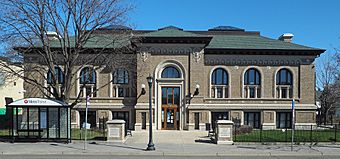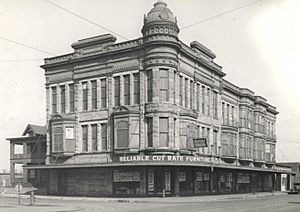Franklin Library (Minneapolis) facts for kids
Quick facts for kids |
|
|
Franklin Branch Library
|
|

Franklin Library viewed from the south
|
|
| Location | 1314 East Franklin Avenue, Minneapolis, Minnesota |
|---|---|
| Built | 1914 |
| Architect | Edward L. Tilton; Elliott, J. & W.A. |
| Architectural style | Renaissance Revival |
| NRHP reference No. | 00000545 |
| Added to NRHP | May 26, 2000 |
The Franklin Library is a public library in Minneapolis, Minnesota. It is located on Franklin Avenue. This library was one of many built with money from the Carnegie Corporation. The Carnegie Corporation was a group started by businessman Andrew Carnegie. He helped build libraries all over the world.
The Franklin Library was designed by Edward Lippincott Tilton, an architect from New York City. It opened in 1914. The library has always been important to immigrant communities. It once had the largest collection of books in Scandinavian languages. Today, it serves many different language groups.
Contents
Early Days: South Side Branch (1890-1914)
Before the Franklin Library, there was another library branch nearby. It was called the South Side branch. This branch opened on April 23, 1890. It was the second library branch in Minneapolis.
The South Side branch was located in two rooms inside a store. This area of Minneapolis was home to many people from Scandinavia. Because of this, the South Side branch became a center for Scandinavian books. In 1914, the Franklin Library took its place. It was the first "Carnegie library" to open in Minneapolis.
Franklin Library: A Community Hub
Andrew Carnegie gave money for library buildings. But communities had to provide the land. The McKnight family donated land worth $13,000 for the Franklin Library. Carnegie then provided $41,000 for the building itself.
The library quickly became very popular. In the 1920s, it was one of the busiest branches. Its large collection of Scandinavian books brought people from all over. The Franklin Library has always been a place for new immigrants. Today, it is a central spot for the Somali community.
The Phillips neighborhood, where the library is, has a rich history. It has been home to immigrants, Native Americans, and African-Americans. The library has a special collection of American Indian books. In the 1960s, it started helping neighbors connect with social workers.
In 2000, the library was added to the National Register of Historic Places. This means it is a special historic building. In 2005, the library was updated. It got new technology but kept its historic look. In 2008, the Franklin Library joined the Hennepin County Library system.
Art at the Library
The Franklin Library has beautiful public art. One piece is a large mosaic called Red Lake. It is above the east fireplace. This mosaic was created by Robert DesJarlait. He is a member of the Anishinabe Ojibwe nation.
DesJarlait's art honors the Ojibwe creation story. It includes symbols of clans, nature, and the stars. He uses pictographs, which are picture symbols, to tell a story. This honors the traditional storytelling ways of Native Americans. The mosaic also remembers ten people who died in 2005 on the Red Lake Reservation.
Another mosaic is above the west fireplace. It is called World Language. Minneapolis artist Marilyn Lindstrom created it. This artwork celebrates the seven continents of the world. It shows ancient symbols and pictographs from each continent. Lindstrom also worked with DesJarlait on his Red Lake mosaic.
Serving the Community
The Franklin Library changes with the people it serves. Today, its book collection includes many languages. These include Arabic, Ojibwe, Oromo, Somali, and Spanish. This shows the many different languages spoken in the homes nearby.
Learning Centers and Programs
The Franklin Library offers many programs for its community.
Franklin Learning Center
The Franklin Learning Center started in 1988. It helps adults learn and improve skills. People can study English, math, science, and technology. They can also prepare for the GED test or U.S. citizenship exams. Learners get help from instructors and volunteer tutors.
Franklin Teen Center
The Franklin Teen Center helps immigrant teens. It supports them as they settle into life in Minneapolis. Teens can take technology classes and get help with homework. They also learn important life skills. Past programs have included tech workshops and groups for young achievers.
Phillips Technology Center
The Phillips Technology Center is a special learning place. It opened in 1997. It is on the lower level of the library. This center offers free computer training and free access to technology. It is a partnership between the library and other community groups.
The library also has a 4-H Mentoring Club. This group has put on programs like a celebration for Somali Independence Day.
Library Renovations
The Franklin Library is one of the oldest Carnegie libraries left in Minneapolis. In 2005, it had a big renovation. The City of Minneapolis Library spent $4 million to update the building.
The library was originally designed by Edward L. Tilton. He was known for designing libraries. The building needed a lot of work. Money for the updates came from the City of Minneapolis.
During the construction, the library moved next door. This allowed them to keep serving people. Community members, called "Friends of Franklin," helped raise money. They raised over $250,000 to keep library services going.
The renovation started in August 2003. The library reopened in May 2005. The updates included fixing an original skylight. They also made bigger areas for children and a special space for teens.
Images for kids






